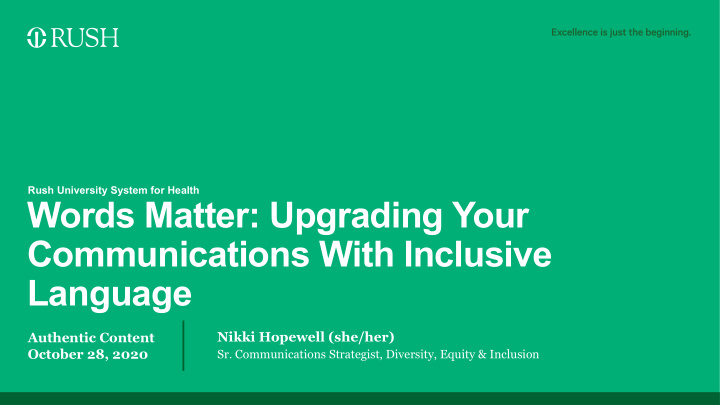



Rush University System for Health Words Matter: Upgrading Your Communications With Inclusive Language Nikki Hopewell (she/her) Authentic Content October 28, 2020 Sr. Communications Strategist, Diversity, Equity & Inclusion
1 What inclusive language really is … and what it is not 2 Why inclusive language matters at your organization 3 Guiding principles to help steer your communications 4 How to operationalize and put inclusive language into practice Rush University System for Health | 10/27/20 2
What inclusive language really is 1 … and what it is not
Problematic inclusive language definitions 1 1 2 2 3 3 Inclusive language … Inclusive language … Lorem ipsum dolor sit Lorem ipsum dolor sit Inclusive language … Lorem ipsum dolor sit Mission Avoids biases, slang and everyday Avoids gendered or exclusive Mission Avoids expressions that Mission phrases with racist origins. terms that will decrease the discriminate against groups of Vision Vision Vision likelihood of attracting a targeted people based on race, gender or Roles Roles Roles candidate profile. socioeconomic status. Entrustable Professional Activities Entrustable Professional Activities Entrustable Professional Activities (EPAs) (EPAs) (EPAs) Rush University System for Health | 10/27/20 4
What inclusive language is not … Inclusive language is: • Not about political correctness • Not tiptoeing around “land mines” • Not restrictive Rush University System for Health | 10/27/20 5
So what is inclusive language really? Inclusive language is about putting into practice effective language that is: • Accurate • Respectful • Relevant to everyone BONUS: When it’s done properly, it’s expansive because it reflects diversity and inclusion. Rush University System for Health | 10/27/20 6
Empowering inclusive language definition Rush University System for Health | 10/27/20 7
Why inclusive language matters at 2 your organization
What is inclusion? Rush University System for Health | 10/27/20 9
Why inclusive language matters Language is a powerful tool … It can either build inclusion/belonging/connectedness or exclusion at work, depending on how it’s used. The power of inclusive language It drives organizational performance because everyone in your organization will feel: • Valued • Respected • Able to contribute their unique talents Source: #WordsAtWork ; Diversity Council Australia Rush University System for Health | 10/27/20 10
Guiding principles to help steer 3 your communications
Person-first language Person first + disability second = person/individual with a disability *Identity-first language Disability first + person second = disabled person *Caveat: Some people with disabilities may prefer to be acknowledged with identity-first language; always ask their preference to be sure. Personal pronouns Pronouns reflect a person’s gender expression (e.g., She/her, he/him, they/them, ze/zir). It signals affirmation and respect to individuals who are transgender, non- binary, gender non-conforming and cisgender. Gender-neutral/gender-inclusive language Recognizes that others exist outside of the gender binary and is a powerful way to promote equality and get rid of gender bias (e.g., chairman becomes chairperson or chair). Service line or presentation name | Rush University System for Health | 10/27/20 12
Breaking down ableist language What is ableist language? Language that’s offensive to people with disabilities. It can refer to language that’s abusive, derogatory or negative toward people with disabilities or when disability is stereotyped, stigmatized or pitied. Ableist Words Recommended Alternatives Confined to a wheelchair Wheelchair user Crazy (insulting to mental health issues) Person with a mental health condition Normal Neurotypical Blind spot Unconscious bias Tone deaf Insensitive, out of context Rush University System for Health | 10/27/20 13
What’s in a personal pronoun? “Preferred pronouns” is problematic. It suggests that it’s a preference and not necessary. Simply ask, “What are your pronouns?” Context is everything. It’s important to match the pronouns that individuals are using for themselves, even if it varies in different settings. They may choose to vary pronouns for reasons of: • Safety, if they’re in a unfamiliar setting • Concerns around self-disclosure if they’re not yet out Visit my www.mypronouns.org to learn more about why pronouns matter. Rush University System for Health | 10/27/20 14
Put it in neutral Well-intended neutral words tend to be masculine in nature. So, for example, instead of “Hey, guys,” try …
Key things to remember about inclusive language 1. Have a willingness to fold in as many people as possible when you communicate. 2. Be ready to learn, listen and understand the people you are addressing and communicating about. 3. If in doubt, please see Nos. 1 and 2.
How to operationalize and put 4 inclusive language into practice
Where do I start? Learn the Platinum Rule (vs. the Golden Rule) The Golden Rule: Treat others the way you would have them treat you, gets an upgrade to the Platinum Rule: Treat others the way they would want to be treated. This requires us to not just tolerate or even acknowledge differences but celebrate them. It starts with me Take steps to embrace inclusive language yourself: • Educate yourself. Learn terminology and best practices. • Practice actively listening to others. • Use it yourself so it becomes habit and models behavior for others. • Exercise compassion for yourself if you make a mistake. Acknowledge Inclusive language is a seal of commitment that reflects your it, apologize, learn from it and move on. dedication to diversity and inclusion within your organization. Rush University System for Health | 10/27/20 18
Thank you! Bye, everyone! ☺
Recommend
More recommend